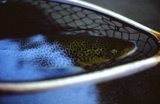
A few days back a customer breeched me on the subject of keeping a fish or two. In the state of Utah with the recent change in regulations on several of our streams back to general fishing regulations, allowing the use of bait, this subjects has been a hot topic. The DWR (Division of Wildlife Resource) is concerned about the fish health on some waters, stating literally that there are too many trout in some of them. Their impression is that flyfishers won't keep fish, so their only option for these fisheries is to change the regulations that would allow more fish to be harvested and for all anging methods to be used. Needless to say there was an our cry from the trout fishing population to leave the regulations as they were.
Now my friend, who likes to keep a fish or two, was concerned about how he would be treated if he kept a couple of browns from the Provo River. He felt that should he be seen leaving the river with a few tasty little
Salmo trutta's that he would be crucified by his fellow constituents. Personally, I don't know if that would be the case, but I wouldn't be surprised if a few words would be exchaned upon departure under such circumstances.
After being in this business for twenty five years my position on catch and release, the keeping of fish, and fishing regualtions as a whole have changed considerably. Back in them earlier more nieve days, so to speak, I wanted every fishery that was worthy to be Catch and Release. Having cut my teeth on the banks of Silver Creek and the Henry's Fork and seeing the successes that C & R regulations had on these incredible resources, I wanted the same for all the other waters that I fished. We'll you can see what success my lobbing efforts have had since in the state of Utah we don't have a singgle C & R fishery. In fact to date, we only have a single flyfishing only water and not a single water that has a C & R regulation. At this juncture, I don't know that I want any of that to change. However, that's not to say that I was in favor of the recent regualtions change. That was an absurd and ill conceived change that still does't sit well with me and should be reversed.
Some of our best flyfishing waters in Utah are those that have a general fishing regulation. Not for the sheer number of fish, but for the size of the trout these waters hold. The reason they have such large fish is there isn't much room for competition among these fish since most of these waters don't harbour very dense populations. The keeping of fish has something to do with that. This was one of the arugments that the DWR posed regarding their justification for a regulation change on the Middle Provo (they just left out a number of other significant factors that also contributed to the decline in overall fish health). I believe that the Lower Provo, which has over 3000 trout/river mile could use a little thinning out. Nature has been doing a fair job of this every winter. Those fish with mold of them are evidence of an overpopulated fishery combined with fishing pressure and water levels.
Regualtions create a strange perception about the viability of a fishery. For example, if a fishery has a bait fishing reg attached to it, most flyfishers assume it to be not very good. If you should put a more restrictive regulation on these waters, I'm farily confident that you would see a steady increase in their use. Look what happened to the Green. You would also see the fish counts start to increase along with angler success. But, it's biologicially proven that as numbers increase, size is inversly effected.
Those waters with general fishing regulations don't draw the crowds in part because of thier low trout densities. Most anglers who fish the Provo or Green are use to catching a dozen trout or more in an outting. These waters that I'm referring to that permit the use of all angling methods acceptable by the state, don't support the numbers of trout that our more populars fisheries do. A couple of decent fish can be a farily stantard day with an exceptional day maybe approaching a half dozen. Most flyfishers today are playing a numbers game where a day of only a few doesn't cut the mustard and double diget days are the measuring stick.
What many don't realize is that C & R fishing practices yeilds about a 10% mortality rate. Simple math; for every 10 fish you land one dies. Although when we let trout go, they have a far better options of living than bonking them on the head, like it or not we are still killing a fair number of those fish when we let them go. So letting them all go, as we are fond of saying, does have its impact on trout mortality. Although we aren't harvesting these fish, our net affect is quite similar.
Keeping a fish or two in a number of instances will not have much effect on a fishery and in many instances may improve them. Those Uinta streams where you can catch as many little trout as you want would be enhanced if a few fish were culled out. Of our more popular waters, the Lower Provo, which boast and incredible 3000 +/fish/river mile, may produce some larger more healthy fish if their numbers were thinned out. However, we tend to keep trout like we kill our prized bulls. If you are planning on keeping a fish or two, don't take the prized bulls. Leave those trout to spawn the next generation. Those fish that you may hook a little to deep, or are a little "Snaky", should be the ones we take.
As much as C & R fishing practices have improved our waters it does have its impact and the fact that it does yield a 10% mortality rate in the long run, will benefit some waters, but can have more detrimental impacts on others. Selective harvesting when practiced with some thought can positively benefit those waters where trout populations are extreme. Pick your waters, pick your trout, and more importantly know your facts before you get on someone’s case over the taking of a trout for the frying pan every once in a while. And if you are really concerned about the health of the waters you fish, limit the number of fish you catch each day. I have since I've owned the shop. My magic number is the old general fishing regulations limit 8, which I rarely get to. We will save that subject for another Blog down the road.
 Since our meeting with Kevin Carter a lot has happened. I don’t know that we have made progress; I’d like to think that we have but, the picture is definitely clearing up. The bottom line is we have two government agencies that really don’t like each other and have done a poor job of communicating back and forth over the years. Getting them both on the same page for now is what needs to happen.
Since our meeting with Kevin Carter a lot has happened. I don’t know that we have made progress; I’d like to think that we have but, the picture is definitely clearing up. The bottom line is we have two government agencies that really don’t like each other and have done a poor job of communicating back and forth over the years. Getting them both on the same page for now is what needs to happen.





